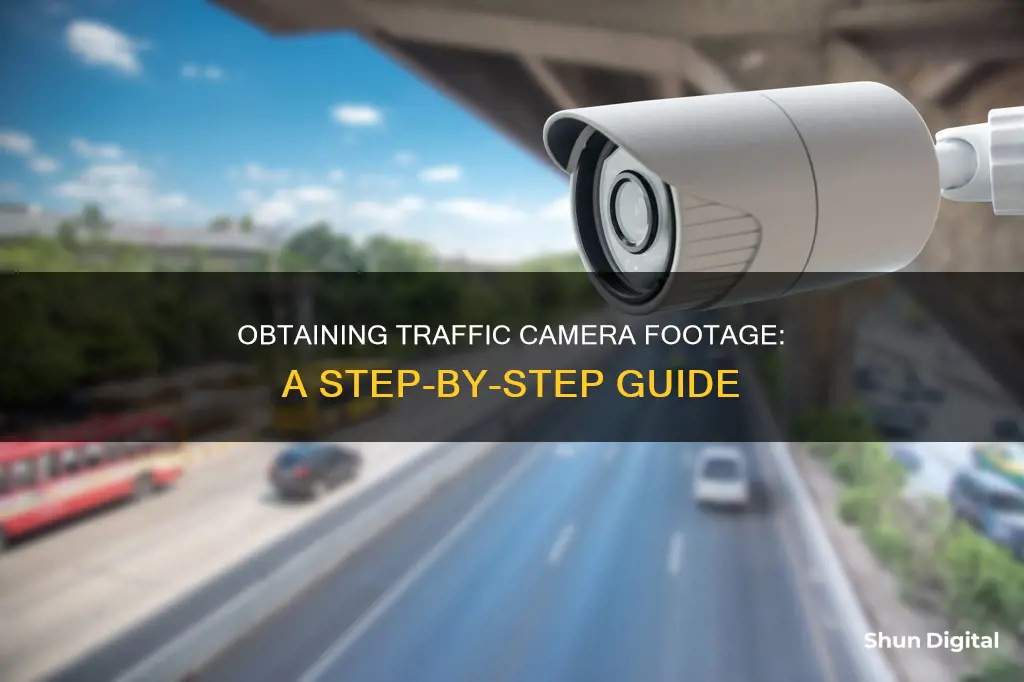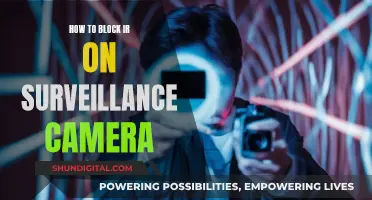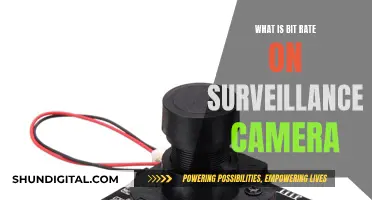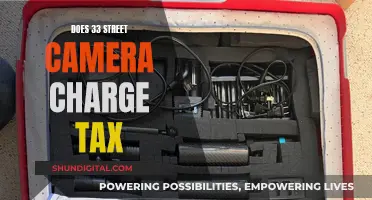
Traffic camera footage can be crucial in determining the cause of a road accident and holding responsible parties accountable. However, obtaining this footage can be a complex and frustrating process. The procedure for obtaining traffic camera footage varies depending on the location and the owner of the camera. This paragraph aims to provide a comprehensive guide on how to request traffic camera footage after a vehicle accident, including the steps to take and the potential sources of footage.
| Characteristics | Values |
|---|---|
| First Step | Identify the location of the traffic camera |
| Second Step | Determine the jurisdiction of the camera |
| Third Step | Contact the appropriate agency |
| Fourth Step | Request the video footage |
| Fifth Step | Review the footage |
| Sixth Step | Seek legal advice |
What You'll Learn

Identify camera location
Identifying the location of the traffic camera is the first step in obtaining traffic camera video footage of a car accident. Here are some ways to do that:
- Review the police report: The police report may contain information on the location of the traffic camera that captured the crash.
- Contact the local police department: The local police department may be able to provide information on the location of the traffic camera.
- Contact the department of transportation: The department of transportation can help you identify the location of the traffic camera, especially if it is located on a highway or a major road.
- Use online resources: Websites like WeatherBug and PhotoEnforced.com provide live traffic camera footage from various cities and locations. You can use these resources to identify the location of the traffic camera near your accident.
- Check with local businesses and residents: If your accident occurred near a company's building or in a residential area, there may be security camera footage available. Reach out to the businesses or homeowners nearby to inquire about any security cameras that may have captured the incident.
Obscured License Plates: Fighting Camera Tickets
You may want to see also

Determine camera jurisdiction
Once you've identified the location of the traffic camera, you need to determine the jurisdiction of the camera. This is important because different agencies have jurisdiction over different areas of a city or state, and this will determine who to contact to obtain the video footage.
For example, if the camera is located in Henderson, Nevada, the Las Vegas police could not simply obtain a copy of the footage without help from the Henderson police, which oversees and is responsible for its own jurisdiction.
Different agencies (metropolitan, sheriff, etc.) have different jurisdictions. Insofar as traffic camera footage is concerned, a jurisdiction might not even lie with the police since the cameras might be operated by the Department of Transportation or a private firm, depending on the state and county.
Identifying the jurisdiction is critical, as it will determine who to contact to get a copy of the footage. The jurisdiction is directly tied to the camera's location.
Police Car Cameras: An American Standard?
You may want to see also

Contact the relevant agency
Once you have identified the agency responsible for the traffic camera footage, the next step is to reach out to their representatives. The relevant agency could be the local police department, Department of Transportation, or a private firm. These agencies all have contact information available to the public.
Depending on the policies of the jurisdiction's government agency responsible for storing the traffic camera footage, you can typically contact them to request access to the video record via phone, email, or their website. You may have to download a PDF form to fill out and email back as an attachment or upload it to make the formal video record request.
You can contact these agencies directly or have a proxy, such as a lawyer, contact them on your behalf. While a lawyer is not required to help you get traffic camera footage, they can be beneficial. They have likely done it before, and they can help you get a subpoena from the local court system if necessary.
Be prepared to provide details about the accident, including the date, time, location, and any other relevant information. After you've requested the video footage, follow up on your request to ensure that it's being processed. Be persistent but polite in your follow-up calls or emails.
Troubleshooting Camera Focus Issues on the Nikon D7500
You may want to see also

Provide accident details
To request traffic camera footage, you must first gather all the details of the accident. This includes the date, time, and location of the crash. It is also important to narrow down the request to specific windows of time, usually within a range of a few hours, to make the process faster. The more specific you can be about the time, the easier it will be to find the relevant footage.
If you are still at the scene of the accident, look around to see if any nearby businesses or residences have cameras. If you have already left the scene, you can look up the area online to find business names and addresses. This will help you identify the possible sources of camera footage.
Once you have identified the location of the traffic camera, you need to determine its jurisdiction. This is important because it will determine who you need to contact to obtain the video footage. The camera could be operated by the local police department, department of transportation, or a private company.
After you have identified the jurisdiction, you can contact the appropriate agency to request the video footage. Be persistent but polite in your follow-up calls or emails. Some agencies may require you to provide a release form before releasing the video footage, and some may charge a fee for providing the footage. Make sure to ask about any requirements or fees before finalizing your request.
It is important to act quickly when requesting traffic camera footage, as the footage is usually stored for only a few days to several weeks before being recorded over. In some cases, it may be stored for longer periods, up to several months or even years. However, once the footage has been deleted, it is usually not recoverable.
Fight Speeding Tickets: Know Your Rights, Louisiana
You may want to see also

Review footage
Once you have obtained the traffic camera footage, you should review it carefully. Take note of any details that may help determine the cause of the accident, such as the position and speed of the vehicles involved. You should also make notes on the footage to enhance your car accident case and increase your odds of winning your claim.
The footage may contain sensitive information, such as the identity of other drivers or passengers involved in the accident. Use the footage responsibly and only share it with others who have a legitimate need to see it.
If you are unsure about how to proceed after obtaining the video footage, seek legal advice from an experienced car accident attorney. They can advise you on how to use the video footage effectively and protect your rights and obligations.
In some cases, accident reconstruction experts can use the footage to reconstruct the crash and determine factors such as the speed of the vehicles, the sequence of events, and the point of impact. This can be crucial in determining the cause of the accident and holding the responsible parties accountable.
Fixing LG Leon LTE Camera Focus Issues
You may want to see also
Frequently asked questions
You can check online on platforms like WeatherBug or PhotoEnforced.com, or by contacting the local police department or department of transportation.
You will need to provide the exact location of the accident, the date and time, and a reasonable time range for the footage.
In Ohio, requests must be made to the Ohio Department of Transportation (ODOT) or the Ohio Bureau of Motor Vehicles (BMV). For accidents in Missouri, contact the Missouri Highway Patrol (MHP) or local law enforcement agencies.
Obtaining traffic camera footage can take some time, and the process varies depending on the agency. It's important to act promptly as footage may only be available for a limited time, such as 72 hours in the case of ODOT.
Even if there was no official traffic camera footage, there may still be other video evidence available. This could include dashcam footage from nearby vehicles or security camera footage from nearby businesses or residential properties.







